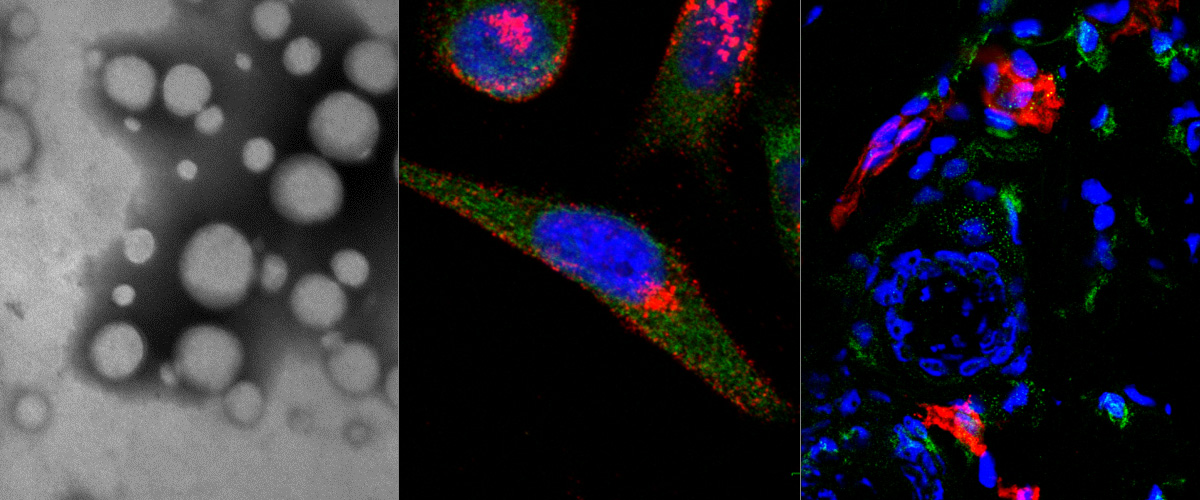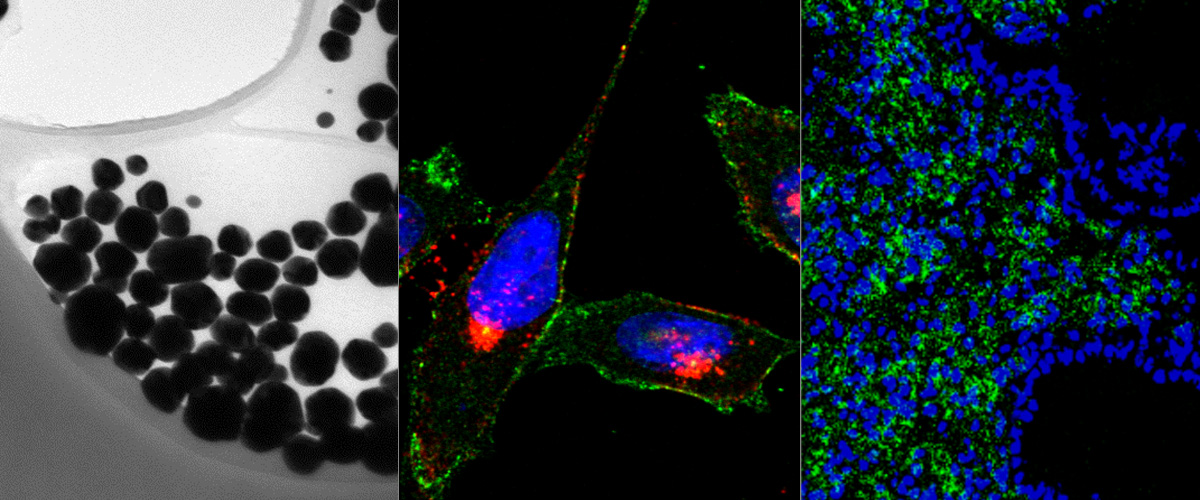T7 phage display platform development
-
Development of ultralow background T7 libraries, including long circulating T7 libraries deficient in liver uptake
-
High-throughput DNA sequencing-based in vitro, ex vivo and in vivo biopanning
-
Development of bioinformatics tools for peptide data mining
Development of nanoparticles for precision-guided drug delivery and imaging of malignant lesions
-
Polymersomes
-
Iron oxide nanoworms
-
Silver nanoparticles
Tumor modeling
-
Xenograft and synegeneic models of prostate, breast, pancreatic, ovarian, and gastric carcinoma, melanoma, and glioma
-
Development of patient-derived xenograft models of glioma and peritoneal carcinomatosis
Intravital imaging using the following equipment
-
Olympus FV1200MPE two photon microscope
-
Optix MX3 (Art Advanced Research Technologies Inc.) fluorescence-luminescence imager
-
Illumatool fluorescence imager (Lightools Research Inc.)
-
The Bruker 9.4T horizontal bore MRI scanner
Graduate student positions (PhD/MSc) available in the Laboratory of Precision- and Nanomedicine of the Institute of Biomedicine and Translational Medicine.
Laboratory of Precision- and Nanomedicine is a well-funded, collaborative, interdisciplinary and translationally-oriented laboratory that develops tools for precision preclinical and clinical detection and therapy of solid tumors and neurological diseases. We are based in SIME building across the street from Biomedicum and have access to the state-of-the-art animal facility and high-end research equipment.
Our core technology is applying in vivo peptide phage display to identify homing peptides that bind to specific targets in the vasculature. Corresponding synthetic peptides are explored for targeting drugs, biologicals, and nanoparticles into tumors to increase their therapeutic index. We focus on development of novel diagnostic tests and therapeutics for the early detection and precision treatment of solid tumors (glioblastoma, and breast, prostate, ovarian, prostate, and colorectal carcinoma). Our lab is also at the forefront of development of next generation peptidic shuttles capable of efficient and high capacity payload delivery across the blood brain barrier.
Several positions are currently available for enthusiastic, hardworking and ambitious PhD and MSc students interested in:
- Mapping disease-associated vascular ZIP codes and developing systemic homing peptides in state of the art animal models;
- Development of peptide-guided imaging and therapeutic nanoparticles;
- Mechanistic studies on the homing peptides;
- Advanced cancer and neurological disease modeling in vivo and in culture;
- In vivo imaging of disease using (nano)tracers and advanced imaging techniques (multiphoton microscopy, high-resolution MRI, IVIS/Licor).
Contact This email address is being protected from spambots. You need JavaScript enabled to view it. for more information and scheduling an appointment.
PC3, prostate cancer cells, taking up RPARPAR-AgNPs (red), also showing NRP1 expression (green) and p32 expression (white)
Technical information: Confocal microscopy, 63x magnification.
Author: Anne-Mari Anton Willmore, MSc
Tumor-Penetrating iRGD Peptide Inhibits Metastasis
Sugahara KN, Braun GB, de Mendoza TH, Kotamraju VR, French RP, Lowy AM, Teesalu T, Ruoslahti E.
Mol Cancer Ther. 2015 Jan;14(1):120-8. doi: 10.1158/1535-7163.MCT-14-0366. Epub 2014 Nov 12.
Selective internalization of RPARPAR silver nanoparticles (Ag-RPARPAR) in NRP-1 expressing cells. In mixed culture, Ag-RPARPAR are taken by NRP-1 (green)-expressing PPC1 prostate carcinoma cells but not by M21 melanoma cells not expressing NRP-1.
Technical information: Confocal microscopy, 63x magnification.
Authors: Lorena Simon Gracia, PhD and Anne-Mari Anton Willmore, MSc
Project Name: Brain tumor penetrating peptides
Recently, we have identified tumor penetrating peptides (TPP) that trigger specific penetration of co-administered un-conjugated drugs deep into tumor and increase their therapeutic index. Current TPP target angiogenic tumor vessels and may not be suitable for targeting slow-growing tumors and invasive tumor cells. TPP are composed of functional modules, which can be rearranged to yield peptides of novel specificities.
Our goal is to develop TPP platform for delivery of co-administered drugs to the deadliest brain tumor – glioblastoma (GBM). We will develop glioma-specific TPP (gTPP) by combination of in vivo and ex vivo phage display of constrained peptide libraries on state-of-the-art glioma animal models. These gTPP will be able to penetrate gliomas independent of their angiogenic status, and to deliver co-administered drugs to infiltrating malignant cells far from the bulk glioma lesion.
Demonstration that the penetration of anti-cancer agents to glioma lesions can be specifically increased would be an advance of broad ramifications. First, more drug (or diagnostic probe) can be delivered into a glioma than in a standard regimen. Second, the procedure can help solve the tumor penetration problem by reaching the infiltrative glioma cells that cannot be accessed with conventional delivery. Third, the gTPP will provide an angiogenesis-independent paradigm of tumor penetrative delivery that can be potentially applied to other types of solid tumors. Finally, as the drug does not have to be conjugated to the peptide, once a gTPP has been clinically validated, it can be used to augment the efficacy of any imaging agent or anti-cancer drug - a major advance in glioma therapy could ensue.
The gTPP delivery system may therefore represent a paradigm shift in glioma drug delivery.Annotation:
Funding: current
Project Name: Development of tissue penetrating peptides for targeted drug delivery
Annotation: Limited extravasation of drugs is particularly relevant to cancer therapy, as solid tumors have a high interstitial pressure, presumably because tumor blood vessels tend to be leaky and lymphatic vessels poorly functional. We have identified tumor-homing peptides that effectively and specifically penetrate into tumor tissue and can carry an attached cargo, such as a drug, antibody, or nanoparticle deep into extravascular tumor tissue. These peptides contain both a tumor-specific homing sequence and a tissue-penetrating and cell-internalizing C-end Rule (CendR) motif. The CendR drug delivery platform has significant translational potential. First, more drug can be delivered than using a standard regimen. This means better efficacy and reduced side effects. Second, the procedure can help to solve the tissue penetration problem by achieving deeper and more even drug distribution in target organs than is possible with conventional delivery. Third, a major limitation of synaphic targeting, that the maximum capacity of the delivery is limited by the availability of receptors for the targeting probe, can be circumvented. Finally, the fact that the drug does not have to be conjugated to the peptide means that once a CendR peptide has been clinically validated, its use in combination with other drugs will be greatly simplified.
Specifically, we propose
• to perform in vivo screens using phage libraries containing cryptic CendR to expand the repertoire of CendR peptides specific for tumors and normal organs
• to define the molecular pathway of the CendR-induced transport and to identify protease(s) that activate cryptic CendR elements
• to optimize the ability of the peptides to selectively increase tissue permeability in target tissues
• to test selected peptide-anti-cancer drug combinations in treatment studies.
These studies will lead to improved understanding of the molecular pathway of CendR-mediated tissue penetration, will define the optimal conditions for CendR-mediated tissue penetration, and will expand our arsenal of CendR peptides. A major advance in targeted drug delivery could ensue.
Funding: current



